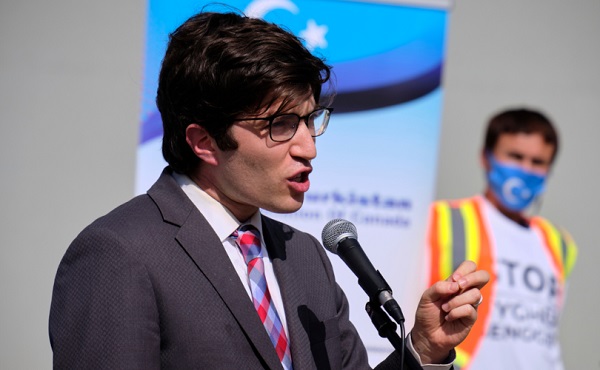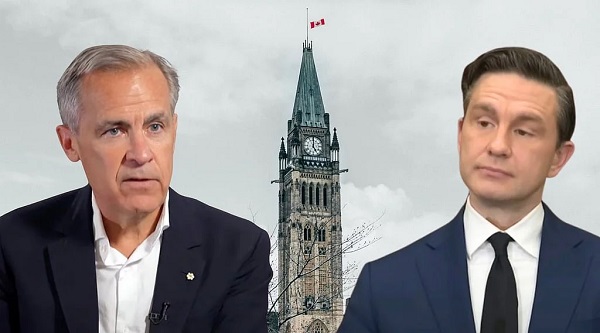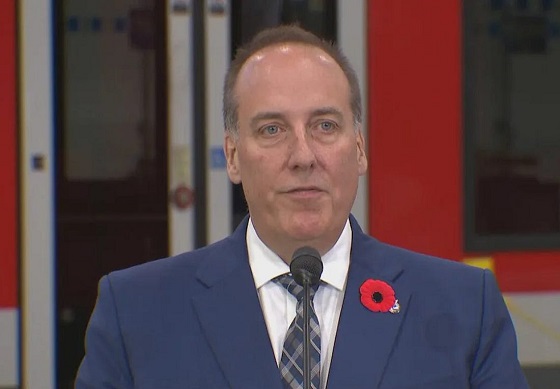Health
Time for an intervention – an urgent call to end “gender-affirming” treatments for children

From the Macdonald Laurier Institute
By J. Edward Les
Despite the Cass Review’s alarming findings, trans activists and their enablers in the medical professions continue to push kids into having dangerous, life-altering surgeries and hormone-blocking treatments. It needs to stop.
If nothing else, the scathing final report of the Cass Review released this week (but commissioned four years ago to investigate the disturbing practices of the UK’s Gender Identity Service), is a reminder that doctors historically are guilty of many sins.
Take the Tuskegee syphilis study, one of the greatest stains on the medical profession, in which impoverished syphilis-infected black men were knowingly deprived of therapy so that researchers could study the natural history of untreated disease.
Or consider the repugnant New Zealand cervical cancer study in the 1960s and 1970s, which left women untreated for years so that researchers could learn how cervical cancer progressed. Or the Swedish efforts to solidify the link between sugar and dental decay by feeding copious amounts of sweets to the mentally handicapped.
The doctors behind such scandals undoubtedly felt they were advancing scientific inquiry in pursuit of the greater good; but they clearly stampeded far beyond the boundaries of ethical medical practice.
More common by far, though, are medical “sins” committed unknowingly, such as when doctors prescribe toxic treatments to patients in the mistaken belief that they are beneficial. When physicians in Europe and Canada latched onto thalidomide in the late 1950s and early 1960s, for instance, they thought it was a wonder drug for morning sickness. Only the fine work of Dr. Francis Kelsey, an astute pharmacist at the FDA, prevented the ensuing birth-defects tragedy from being visited upon American women and children.
And when Oxycontin hit the medical marketplace in the 1990s, physicians embraced it as a marvellous — and supposedly non-addictive — solution to their patients’ pain. But the drug was simply another synthetic derivative of opium, and every bit as addictive; its use triggered a massive opioid overdose crisis — still ongoing today — that has killed hundreds of thousands and ruined the lives of countless individuals and their families.
Physicians in the latter instances weren’t driven by malevolence; but rather by a deep-seated desire to help patients. That wish, compounded by extreme busy-ness, repeatedly seduces doctors into unwarranted faith in untested therapies.
And no discipline in medicine, arguably, is more frequently led astray by the siren song of shiny new things than the field of psychiatry. Which is understandable, perhaps, given the nature of psychiatric practice. Categorizations of mental disorders — and the methods used to treat them — are based almost entirely on consensus opinion, rather than on direct measurement. Contrast that with other domains of medical practice: appendicitis is diagnosed by imaging the infected organ, and then cured by surgically removing the inflamed tissue; diabetes is detected by measuring elevated blood sugar, and then corrected by the administration of insulin; elevated blood pressure is calibrated in millimetres of mercury, and then effectively reduced with antihypertensives; and so on.
But mental disturbances remain largely the stuff of conjecture — learned conjecture, mind you, but conjecture, nonetheless. The Diagnostic and Statistical Manual of Mental Disorders, the “bible” of mental health professionals, is the collective effort of groups of tall foreheads gathered around conference tables opining on the various perturbations of the human mind. Imprecise definitions abound, with heaps of overlap between conditions.
The current version (DSM-5) describes schizophrenia, for example, as occurring on a spectrum of “abnormalities in one or more of the following five domains: delusions, hallucinations, disorganized thinking (speech), grossly disorganized or abnormal motor behavior (including catatonia), and negative symptoms.” Each of these five domains is open to professional interpretation; and what’s more, the schizophrenia spectrum is further subdivided into ten sub-categories.
That theme runs through the entire manual – and imprecise definitions lead on to imprecise solutions. Given the blurred indications for starting, balancing, and stopping medications, it’s no accident that many mentally unwell patients languish on ever-changing cocktails of mind-altering drugs.
None of which is to downplay the enormous importance of psychiatry, which does much to address human suffering amidst unimaginable complexity; its practitioners are among the brightest and most capable members of the medical profession. But by its very nature the discipline is submerged in — and handicapped by — uncertainty. It’s unsurprising, then, that mental health professionals desperate for effective treatments are susceptible to being misled.
The dark history of frontal lobotomies, seized upon by psychiatrists as a miracle cure but long relegated to the trash heap of medical barbarism, is well known. The procedure (which garnered its inventor the Nobel Prize in Medicine) basically consisted of driving an ice pick through patients’ eye sockets to destroy their frontal lobes; thousands of patients were permanently maimed before saner heads prevailed and the practice was halted. Many of its victims were gay men: “conversion therapy” with a literal, brain-altering “punch.”
Similarly, the fabricated “recovered memories of sexual abuse” saga of the 1980s and early 1990s suckered mental health practitioners into believing it was legitimate. Hundreds of professional careers were built on the “therapy” before it was all exposed as a fraud, leaving many lives ruined, families torn asunder, and scores of innocent men imprisoned or dead from suicide. In a 2005 review, Harvard psychology professor Richard McNally pegged the recovered memory movement as “the worst catastrophe to befall the mental health field since the lobotomy era.”
Until now, that is. That scandal pales in comparison to the “gender transition/gender affirming care” craze that has befogged the medical profession in recent years.
Without a shred of supporting scientific evidence, many doctors — led by psychiatrists, but aided and abetted by endocrinologists, surgeons, pediatricians, and family doctors — have bought into the mystical notion of gender fluidity. What was previously recognized as “gender identity disorder” was rebranded as gender “dysphoria” and recast as part of the normal spectrum of human experience, the basic truth of binary mammalian biology simply discarded in favour of the fiction that it’s possible to convert from one sex to another.
Much suffering has ensued. The enabling of biological males’ invasion of women’s spaces, rape shelters, prisons, and sports is bad enough. But what is being done to children is the stuff of horror movies: doctors are using medications to block physiological puberty as prologue to cross-gender hormones, genital-revising surgery, and a lifetime of infertility and medical misery — and labelling the entire sordid mess as gender-affirming care.
The malignant fad began innocently enough, with a Dutch effort in the late 1980s and early 1990s to improve the lot of transgendered adults troubled by the disconnect between their physical bodies and their gender identity. Those clinicians’ motivations were defensible, perhaps; but their research was riddled with ethical lapses and methodological errors and has since been thoroughly discredited. Yet their methods “escaped the lab”, with the international medical community adopting them as a template for managing gender-confused children, and the World Professional Association for Transgender Health (WPATH) enshrining them as “standard of care.” Then, as American social psychologist Jonathan Haidt is the latest to observe, the rise of social media torqued the trend into a craze by convincing hordes of adolescents they were “trans.” Which is how we ended up where we are today, with science replaced by rabid ideology — and with condemnation heaped upon anyone who dares to challenge it.
An explanation sometimes offered for the massive spike in gender-confused kids seeking “affirmation” in the past fifteen years is that today it’s “safe” for kids to express themselves, as if this phenomenon always existed but that — as with homosexuality — it was “closeted” due to stigma. Yet are we really expected to believe that the giants of empirical research into childhood development —brilliant minds like Jean Piaget, Eric Erikson, Lev Vygotsky, and Lawrence Kohlberg — somehow missed entirely the trait of mutable “gender identity” amongst all the other childhood traits they were studying? That’s nonsense, of course. They didn’t miss it — because it isn’t real.
The fog is beginning to dissipate, thankfully. Multiple jurisdictions around the world, including the UK, Sweden, Norway, Finland, and France have begun to realize the grave harm that has been done, and are pulling back from — or halting altogether — the practice of blocking puberty. And the final Cass Report goes even further, taking square aim at the dangerous practice of social transitioning and concluding that it’s “not a neutral act” but instead presents risk of grave psychological harm.
All of which places Canada in a rather awkward position. Because in December of 2021 parliamentarians gave unanimous consent to Bill C-4, which bans conversion therapy, including “any practice, service or treatment designed to change a person’s gender identity.” It’s since been a crime in Canada, punishable by up to five years in prison, to try to help your child feel comfortable with his or her sex.
As far as I know, no one has been charged, let alone imprisoned, since the bill was passed into law. But it certainly has cast a chill on the willingness of providers to deliver appropriate counselling to gender-confused children: few dare to risk it.
A conversion therapy ban had been in the works for years, triggered by concerns about disturbing and harmful practices targeting gay children. But by the time the bill was presented in its final form to Parliament for a vote it had been hijacked by trans activists, with its content perverted to the degree that there is more language in the legislation speaking to gender identity than to homosexuality.
To be clear, likening homosexuality to pediatric “gender fluidity” is a category error, akin to comparing apples to elephants. The one is an innate sexual orientation, the acceptance of which requires simply leaving people be to live their lives and love whomever they wish; the other is wholly imaginary, the acceptance of which mandates irreversible medical (and often surgical) intervention and the transformation of children into lifelong (and usually infertile) medical patients.
And the real “elephant” in the room is that in a troubling number of cases pediatric trans care is conversion therapy for gay children because for some people, it’s more acceptable to be trans than it is to be gay.
Bill C-4 received unanimous endorsement from all parliamentarians, including from Pierre Poilievre, now the leader of the Conservative Party. No debate. No analysis. Just high-fives all around for the television cameras.
It’s possible that many of the opposition MPs hastening to support the ban did so for fear of being painted as bigots. Yet the primary responsibility of an opposition party in any healthy democracy is to oppose, even when it’s unpopular. In 2015, when NDP Opposition leader Tom Mulcair faced withering criticism for resisting anti-terror legislation tabled by Stephen Harper’s Conservative government, he cited John Diefenbaker’s comments on the role of political opposition:
“The reading of history proves that freedom always dies when criticism ends… The Opposition finds fault; it suggests amendments; it asks questions and elicits information; it arouses, educates, and moulds public opinion by voice and vote… It must scrutinize every action of the government and, in doing so, prevents the shortcuts through democratic procedure that governments like to make.”
In the case of Bill C-4 the Conservatives did none of that. And by abdicating their responsibility they helped drive a metaphorical ice pick into the futures of scores of innocent children, destroying forever their prospects for normal, healthy lives.
We’re long overdue for a “conversion”: a conversion back to the light of reason, a conversion back to evidence-based care of children.
In 1962, when the harms of thalidomide became known, it was withdrawn from the Canadian market. In 2024, now that the serious harms of “gender-affirming care” have been exposed, it remains an open question as to when Canada’s doctors and politicians will finally take the difficult step of admitting that they got it wrong and put a stop to the practice.
Dr. Edward Les is a pediatrician in Calgary who writes on politics, social issues, and other matters.
Great Reset
EXCLUSIVE: The Nova Scotia RCMP Veterans’ Association IS TARGETING VETERANS with Euthanasia

I just received an email from a retired member of the RCMP…
“I served for 32 years on the West Coast and retired in 2019. As a Christian and a retired member of the RCMP I wanted to share this with you. I’m trying to wrap my head around this shocking email. I’m shocked it’s come to this.” – L.K
SATURDAY, NOV. 22, 2025
1:30-3:00 PM CHURCH HALL, OLD SACKVILLE ROAD, MIDDLE SACVILLE, NS, B4E 1R3.
On November 20th, an email quietly dropped into the inboxes of Nova Scotia RCMP veterans. Standard, polite and in true Canadian fashion formal and sanitized. This was no mistake, this wasn’t information. This was something different.
This was grooming.
Yes I said it, coercion.
The “opportunity” was a “Medical Assistance in Dying (MAID) Program in Nova Scotia”
This is a state-aligned institutions normalizing death as a service to the very people they already failed to support in life .This was a information session, to “educate” veterans who’s rates of PTSD and suicidality were already sky hight. How they can apply or use MAID.
The invited speaker?
Dr. Gordon Gubitz
Location? None other than a place of worship, a church hall. The target audience?
VETERANS.
This is what I’ve been talking about, welcome to the soft-coercive stage of Canada’s MAID regime.
Let’s meet Dr. Gordon Gubitz. The same Dr. Gubitz whois a MAID assessor and provider (killer) is the Clinical Lead for MAID in Nova Scotia, which means MAID is his not only his passion but spends his work focused on ending lives. This “Dr” sits on the board of CAMAP, the pro death organization that creates all the pathways for Canadians to be killed while manipulating the court systems in their favour. More death to them is the goal. This “Dr” helped write the national MAID curriculum and trains doctors on how to present MAID as a “care option.” This guy is literally a death pusher and peddler of the dark.
Think of him a the drug dealer for death.
They didn’t invite a trauma specialist.
They didn’t invite a palliative expert.
They didn’t invite a police mental-health advocate.
They didn’t invite a mental health expert
They didn’t invite a Dr who looks at psychedelic assisted therapy
They didn’t invite hope. They only invited death.
Kelsi Sheren is a reader-supported publication.
To receive new posts and support my work, consider becoming a free or paid subscriber.
Nova Scotia RCMP veterans invited a man whose job is to facilitate, provide and promote nothing but death, and whose organization teaches clinicians how to introduce MAID (assisted SUICIDE) to patients who didn’t ask for it, bring it up or want it in their life.
Let me explain something, If you’re a veteran dealing with PTSD, chronic pain, TBI, disability, or bureaucracy-induced despair, this isn’t “education.”
This is targeted psychological pressure.
Coercion, CAMAP and Dying with Dignity’s claim to fame.
No one will say the words out loud. No one will write “we think some of you should consider dying.”
They don’t need to, when just dangling the carrot is good enough to get the job done.
Coercion today is subtle, normalized in the community. It’s dressed up like Christmas cookies in a church call, framed as loving “support” being held by one of the most prolific death pushers in the game.
Simply funnelling veterans into the system one “information session” at a time. Like cattle through the gates of hell, with CAMAP waiting in the shadows. This time not with a bold gun. They would see that as “too humane”, but with a pen, check list, a needle and a paralytic.
Canada already proved it’s willing to dangle MAID (assisted suicide, murder, early death) in front of struggling veterans. I helped break these stories and bring our veterans stories to the masses. I’m interviewing more by the day, who’ve been offered death over life illegally.
VAC employees got caught offering MAID to veterans who never asked for it, including one trying to get a wheelchair ramp, my friend Christine.
So do me a favour spare us the “this is innocent” act.
Veterans have been coerced before, and it’s happening again right in front of your faces. Now the RCMP Veterans’ Association is rolling out the red carpet for the prevailers of death. The dark ones who feed on the souls of those who couldn’t bare to take another breath.
This is not an “opportunity.”
This is a sales pitch.
And the product is your death.
People keep asking me why veterans are being targeting? Because they’re the perfect targets, don’t you see?
Kelsi Sheren is a reader-supported publication.
To receive new posts and support my work, consider becoming a free or paid subscriber.
Veterans, on the daily are dealing with chronic pain, combat trauma, moral injury, sanctuary trauma, disability, suicidality, lack of services, financial strain, bureaucratic obstruction and the government doesn’t just know know it, it caused it and it supports it and so do the MAID, pro death cult architects.
The MAID lobby knows veterans are “high-yield” candidates, and not because they want to die, but because the system has already worn them down, like water slowly dripping over the rocks. The Liberal government just cut OVER 4 BILLION in care for veterans. Veterans aren’t being shown the full picture, they aren’t given any hope. They’re being shown the early exit. What we call in some circles, being shown the path to “self-selection.”
This RCMP veterans email is a soft-touch version of coercion if I’ve ever seen one.
“We’re not telling you to choose MAID… we’re just putting the idea on the table, in a friendly community space, with a trusted expert who helps design the national MAID system.” Who’s job is to provide you with all the pathways to wanting to kill yourself.
That’s how you manipulate a vulnerable population without leaving fingerprints.
Dr. Gubitz isn’t neutral. He is the system.
Gubitz isn’t walking into that church as an independent medical educator.
He is walking in as the clinical gatekeeper for MAID in Nova Scotia, IE. HELL. He’s nothing more than one of the ideological engines behind national MAID training. A CAMAP insider, the organization pushing to expand and normalize MAID (assisted SUICIDE) at every level of “healthcare,” if you can even call it that anymore. CAMAP literally publishes guidance on how clinicians should bring up MAID as a care option. Not reactively. Proactively.
When you pair a vulnerable group with a man trained to present MAID as “equitable access,” your “information session” becomes a recruitment funnel.
HOW IS EVERYONE OK WITH THIS?
You are directly influencing and priming veterans for death under the banner of “support.” It’s an illusion, it’s predatory behaviour! It’s not informed consent in any way. It’s manipulation.
And holding it in a church? That’s strategic psychological laundering.
Churches are trusted spaces. They lower defences, help you to open your mind. Churches to most signal moral legitimacy so hosting a MAID talk in a church hall tells veterans “your community approves. Your faith approves this is acceptable, this is dignified, you don’t have to fight or feel guilty, ”
It cloaks a controversial, ethically fraught practice in community warmth. It’s taking advantage of the safety and sanctity of church.
That’s not an accident.
It’s a tactic.
This wreaks of propaganda wrapped in hospitality.
This is the playbook of a system that wants to solve suffering by eliminating the sufferer.
Canada won’t fix the care gaps. It won’t fix the mental-health crisis. It won’t fix VAC’s failures and it sure as hell won’t fix disability supports.
But it will happily fund a national MAID curriculum, expand eligibility, remove guardrails, and now apparently send MAID providers on a tour of vulnerable communities.
Veterans have always been canaries in Canada’s moral coal mine.
If the state can normalize MAID to the people who wore its uniform, it can normalize it to anyone. And that’s the point.
This story isn’t about one email. It’s about a culture shift engineered from the top down.
This is how you create acceptance – – >
First, make MAID look compassionate.
Then, bring it into community spaces.
Then, present to vulnerable groups.
Then, call it “support.”
Then, remove the stigma.
Then, remove the safeguards.
Then, expand eligibility.
Then, tell the public: “People are choosing MAID because it’s dignified.”
They leave out the part where the system helped manufacture despair.
Veterans deserve better than an invitation to die.
They deserve care, treatment, advocacy, and someone who doesn’t treat their suffering as a problem to be erased.
Not a church basement with coffee and a state-aligned MAID architect explaining their “options.”
This email isn’t benign.
It is a warning, one Canada should have heeded years ago.
If the country is comfortable offering death to the people who served it, it’s comfortable offering it to anyone.
And that’s exactly what’s happening.
Please feel free to call or email them and let them know how this makes you feel.
KELSI SHEREN
– – – – – – – – – – – – –
One Time Donation! – Paypal – https://paypal.me/
Buy me a coffee! – https://buymeacoffee.com/
Youtube – https://www.youtube.com/@
Substack: https://substack.com/@
TikTok – https://x.com/KelsiBurns
Listen on Spotify:
|
|
The Kelsi Sheren Perspective
Kelsi Sheren Podcast |
SUPPORT OUR SPONSORS
– – – – – – – – – – – –
Ketone IQ- 30% off with code KELSI – https://ketone.com/KELSI
Good Livin – 20% off with code KELSI – https://www.itsgoodlivin.com/?
Brass & Unity – 20% off with code UNITY – http://brassandunity.com
Kelsi Sheren is a reader-supported publication.
To receive new posts and support my work, consider becoming a free or paid subscriber.
Health
Disabled Canadians petition Parliament to reverse MAiD for non-terminal conditions

From LifeSiteNews
Canadians with disabilities have demanded that legislators stop treating their lives as ‘dispensable’ by banning non-terminal ‘Track 2’ assisted suicide.
Conservative Member of Parliament Garnett Genuis has presented a petition from Canadians with disabilities warning against euthanasia expansion.
During a November 19 session in the House of Commons, Genuis delivered a petition to end Track 2 Medical Assistance in Dying (MAiD) request, which allow doctors to end the lives of those who are not terminally ill but have lost the will to live due to their having chronic health problems.
“The petitioners state that it is unacceptable for Canadians to choose medical assistance in dying due to a lack of available services or treatments,” Genuis told the House of Commons. “This is not a real choice. They point out that allowing MAiD for people with disabilities or chronic non-terminal illnesses devalues their lives. It sends the dangerous message that life with a disability is optional.”
People with Disabilities are Speaking Out On Euthanasia/MAiD
So-called “Track 2 MAiD” has transformed the experience of people with disabilities when accessing the healthcare system.
These petitioners want it reversed. pic.twitter.com/n3izpAQI2T
— Garnett Genuis (@GarnettGenuis) November 17, 2025
Genuis cited a recent article in Le Soleil which recounted the troubling case of a sick Canadian man who was essentially encouraged by a social worker to stop fighting and opt for death by lethal injection.
“That is not compassion. It is a betrayal of our duty to protect human dignity,” he declared.
The petition pointed out that “allowing medical assistance in dying for those with disabilities or chronic illness who are not dying devalues their lives, tacitly endorsing the notion that life with disability is optional, and by extension, dispensable.”
It also pointed out that making MAiD available to individuals with disabilities or chronic illnesses diminishes the motivation to develop better treatments and provide higher quality care for those living with such conditions.
In conclusion, the petition called on the Canadian government to “protect all Canadians whose natural death is not reasonably foreseeable by prohibiting medical assistance in dying for those whose prognosis for natural death is more than six months.”
A few days earlier, on November 17, Liberals responded to the petition by claiming that they have implemented “safeguards” to assess if someone is eligible to receive MAiD.
“These safeguards aim to address the risks associated with diverse sources of suffering and vulnerability, that could lead someone not close to death to seek MAiD,” Liberals wrote. “The safeguards examine whether their suffering results from factors other than the medical condition and whether there are ways of addressing their suffering other than through MAiD.”
However, this is not the first time that Canadians have petitioned to protect vulnerable Canadians from the ever-growing euthanasia regime.
As LifeSiteNews reported in October, Inclusion Canada CEO Krista Carr told Parliament that many disabled Canadians are being pressured to end their lives with euthanasia during routine medical appointments.
Similarly, internal documents from Ontario doctors in 2024 that revealed Canadians are choosing euthanasia because of poverty and loneliness, not as a result of an alleged terminal illness.
In one case, an Ontario doctor revealed that a middle-aged worker, whose ankle and back injuries had left him unable to work, felt that the government’s insufficient support was “leaving (him) with no choice but to pursue” euthanasia.
Other cases included an obese woman who described herself as a “useless body taking up space,” which one doctor argued met the requirements for assisted suicide because obesity is “a medical condition which is indeed grievous and irremediable.”
At the same time, the Liberal government has worked to expand euthanasia 13-fold since it was legalized, making it the fastest growing euthanasia program in the world.
Currently, wait times to receive actual health care in Canada have increased to an average of 27.7 weeks, leading some Canadians to despair and opt for euthanasia instead of waiting for assistance. At the same time, sick and elderly Canadians who have refused to end their lives have reported being called “selfish” by their providers.
The most recent reports show that euthanasia is the sixth highest cause of death in Canada; however, it was not listed as such in Statistics Canada’s top 10 leading causes of death from 2019 to 2022.
Asked why it was left off the list, the agency said that it records the illnesses that led Canadians to choose to end their lives via euthanasia, not the actual cause of death, as the primary cause of death.
According to Health Canada, 13,241 Canadians died by euthanasia lethal injections in 2022, accounting for 4.1 percent of all deaths in the country that year, a 31.2 percent increase from 2021.
-

 Crime2 days ago
Crime2 days ago‘Modern-Day Escobar’: U.S. Says Former Canadian Olympian Ran Cocaine Pipeline with Cartel Protection and a Corrupt Toronto Lawyer
-

 National18 hours ago
National18 hours agoPsyop-Style Campaign That Delivered Mark Carney’s Win May Extend Into Floor-Crossing Gambits and Shape China–Canada–US–Mexico Relations
-

 COVID-1915 hours ago
COVID-1915 hours agoCovid Cover-Ups: Excess Deaths, Vaccine Harms, and Coordinated Censorship
-

 Bruce Dowbiggin16 hours ago
Bruce Dowbiggin16 hours agoBurying Poilievre Is Job One In Carney’s Ottawa
-

 Alberta1 day ago
Alberta1 day ago‘Weird and wonderful’ wells are boosting oil production in Alberta and Saskatchewan
-

 Alberta2 days ago
Alberta2 days agoAlberta on right path to better health care
-

 Alberta1 day ago
Alberta1 day agoAlberta to protect three pro-family laws by invoking notwithstanding clause
-

 Energy1 day ago
Energy1 day agoThe Carney Government is Hijacking the Phase “Energy Superpower” to Advance Their Agenda







